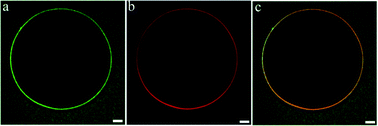Charge-driven co-assembly of polyelectrolytes across oil–water interfaces
Abstract
We report a simple strategy to co-assemble oppositely charged polyelectrolytes across oil–water interfaces; this allows the accumulation of an electrostatic complex at the interface of species that are not surface active by themselves. To this end, we use a new, oil-soluble anionic polymer, poly-(fluorene-co-benzothiadiazole-co-benzoic acid), in combination with a cationic polyelectrolyte that is dissolved in the aqueous phase. When only one of the two charged components is present, no positive adsorption is observed in interfacial tension measurements; by contrast, when both polyelectrolytes are present, in the oil and water phases respectively, a rapid decrease of the interfacial tension is observed, indicating co-adsorption of the cationic and anionic polyelectrolytes. The complexation strength can be tuned through changes in both ionic strength and pH. Confocal microscopy and co-localization analysis further verifies the presence of both polyelectrolytes at the interface. With this approach, emulsions can be stabilized for several weeks; moreover, using the sensitivity of the complex to changes in pH, we are able to reversibly break and make the emulsions on demand.


 Please wait while we load your content...
Please wait while we load your content...